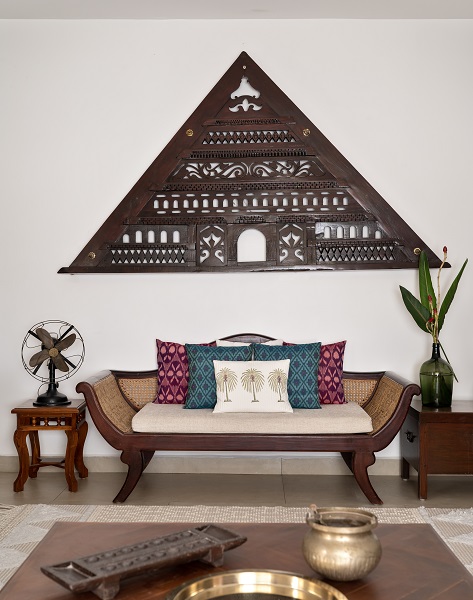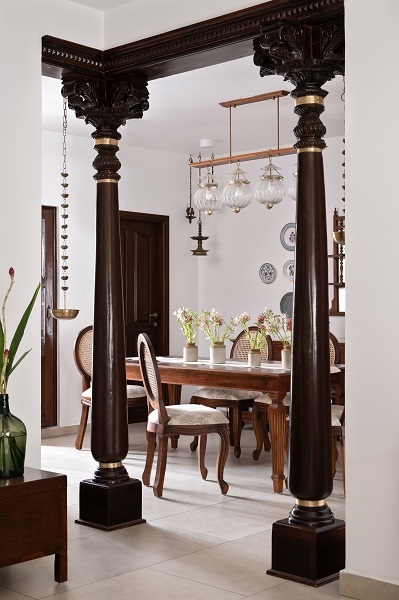“Immersed in the cultural tapestry of temple towns, our architectural journey embraces sustainability and cultural sensitivity. From vibrant fabrics to intricate art, we integrate elements like sustainable athangudi tiles and recycled teak wood, crafting spaces that honor tradition while resonating deeply with their occupants.”
How do cultural elements influence your design process, and how do you incorporate them into your architectural creations?
My inspiration has always been my country and the people around me. The wealth of natural beauty that surrounds us continues to inspire me to delve deeper into every aspect of our culture let it be art, fabrics, interiors, or architecture A very important aspect of our design process is to incorporate cultural elements. For example we used sustainable athangudi tiles in one of our projects along with recycled and reused teak wood, the fabrics were a mix of Kerala handloom and silks.

How has technological integration transformed the way architects and designers approach their projects?
Advanced computer-aided design (CAD) software and building information modeling (BIM) tools empower architects and designers to craft intricate 3D models of their projects, facilitating precise visualization for stakeholders. This clarity aids in informed decision-making and early issue detection prior to construction initiation. Parametric design software further amplifies their capabilities, allowing for the creation of intricate, bespoke structures through parameter-driven algorithms. This flexibility not only optimizes performance criteria but also encourages exploration of cutting-edge design solutions. Additionally, software tools dedicated to sustainable design analysis enable professionals to evaluate the ecological footprint of their creations, guiding decisions to minimize energy consumption, carbon emissions, and resource depletion. By integrating sustainable principles from the project’s outset, architects and designers contribute to environmentally responsible construction practices.

When renovating historic structures, how do you balance preserving the original charm while incorporating modern functionalities?
The renovation process begins with a deep understanding of the historic significance and architectural features of the structure. This entails identifying elements that contribute to its charm, including original materials, decorative details, and unique architectural features. The focus is on prioritizing the restoration of key historic elements that define the building’s character, such as facades, ornamental details, and interior finishes. Traditional techniques and materials are employed to ensure authenticity and preserve continuity with the original design.
How do color palettes influence the ambiance and emotional response within interior Spaces?
Color palettes play a crucial role in influencing the ambiance and emotional response within interior spaces. Different colors evoke distinct feelings and moods, affecting occupants’ perceptions and behaviors. Warm colours like red, orange, and yellow are associated with energy, warmth, and stimulation. They can create a cosy and inviting atmosphere, making spaces feel intimate and lively. However, intense warm colors like red may also evoke feelings of excitement or even agitation if used excessively. Cool colors such as blue, green, and purple are calming and soothing, evoking a sense of serenity, relaxation, and tranquility, making them ideal for promoting a sense of peace and well-being in interior spaces. Lighter can create an airy and spacious feel, while darker shades add depth and sophistication. Neutral colors like white, beige, gray, and taupe provide a versatile backdrop that can complement any design style exuding simplicity, elegance, and timelessness, allowing other elements in the space to stand out.

In what ways does biophilic design enhance the overall ambiance and well-being of occupants in architectural spaces?
Biophilic design nurtures a profound connection with nature through the integration of elements like abundant natural light, panoramic views of lush greenery, indoor plants, and the use of raw materials such as wood and stone. This connection has been associated with diminished stress levels, uplifted moods, and heightened productivity among residents. Additionally, features like natural light, soothing water elements, and organic shapes craft visually captivating surroundings that amplify the allure of spaces, elevating satisfaction and fostering deeper relaxation and enjoyment for inhabitants.

How is AI and IoT transforming the concept of smart homes, and what impact does it have on user convenience and efficiency?
AI and IoT seamlessly automate various home systems and devices, including lighting, heating, cooling, security cameras, and appliances. Smart home hubs or assistants, such as Amazon Alexa or Google Assistant, utilize AI algorithms to comprehend and execute voice commands, enabling users to remotely control their devices or set up automated routines. This automation simplifies daily tasks and routines, enhancing convenience. Furthermore, AI-powered smart home devices adapt to users’ preferences and behaviors over time, offering personalized experiences tailored to individual needs. For instance, smart lighting systems adjust color temperatures and brightness levels based on occupants’ daily activities, creating custom lighting scenes for different times of the day or specific tasks.


